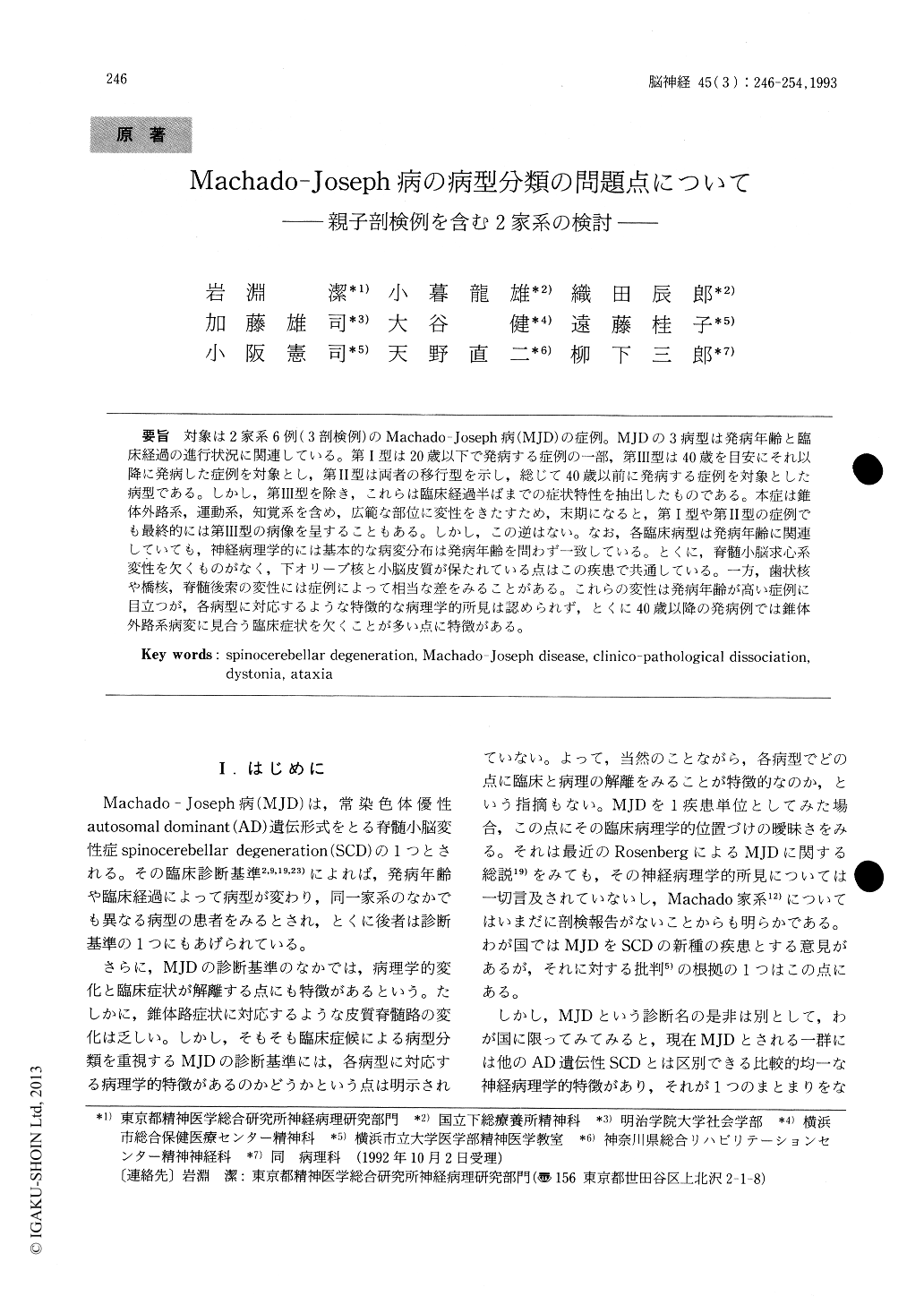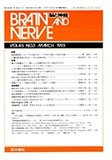Japanese
English
- 有料閲覧
- Abstract 文献概要
- 1ページ目 Look Inside
対象は2家系6例(3剖検例)のMachado-Joseph病(MJD)の症例。MJDの3病型は発病年齢と臨床経過の進行状況に関連している。第I型は20歳以下で発病する症例の一部,第III型は40歳を目安にそれ以降に発病した症例を対象とし,第II型は両者の移行型を示し,総じて40歳以前に発病する症例を対象とした病型である。しかし,第III型を除き,これらは臨床経過半ばまでの症状特性を抽出したものである。本症は錐体外路系,運動系,知覚系を含め,広範な部位に変性をきたすため,末期になると,第I型やII型の症例でも最終的には第III型の病像を呈することもある。しかし,この逆はない。なお,各臨床病型は発病年齢に関連していても,神経病理学的には基本的な病変分布は発病年齢を問わず一致している。とくに,脊髄小脳求心系変性を欠くものがなく,下オリーブ核と小脳皮質が保たれている点はこの疾患で共通している。一方,歯状核や橋核,脊髄後索の変性には症例によって相当な差をみることがある。これらの変性は発病年齢が高い症例に目立つが,各病型に対応するような特徴的な病理学的所見は認められず,とくに40歳以降の発病例では錐体外路系病変に見合う臨床症状を欠くことが多い点に特徴がある。
This study proposed that three phenotypes of Machado-Joseph disease (MJD) are closely related to the patients' ages at onset.
Materials : Six patients from two families. Autopsy performed in three of them (case 2, 4, 5) . Two patients are a father (case 4) and his son (case 5).
Results : 1. Clinical features. All cases showed cerebellar ataxia and nystagmus. Progressive nuclear oculomotor palsy was common except for one case who killed himself in the early clinical stage. Pyramidal symptom which is increased deep tendon reflexes, spasticity, and extesor plantar response was common for three patients (case 3, 5, 6) whose ages of onset are under 40 years. One case (case 5) developed dystonia of foot at the age of ten and he developed the symptom of type 1 of MJD. However, the other three patients (case 1, 2, 4) who developed ataxia after the middle of the fifth decade showed hypotonia and decreased or absence of deep tendon reflexes from the beginning. The latter did not revealed spasticity or dystonia. Their clinical symptoms were identical with the type 3 of MJD. In spite of ages at onset, they showed general muscular atrophy and sensory disturbance in the advanced clinical course.
2. Neuropathological findings. 1) cerebellar sys-tem : Severe degeneration in the spinocerebellar system and mild to moderate one in the pontoce-rebellar system and dentate nuclei. The inferior olivary nucleus and the cerebellar cortex were almost preserved. 2) extrapyramidal system : Moderate to severe degeneration in the substantia nigra, globus pallidus (prominent in the internal segment) and subthalamic nucleus. 3) Degenera-tion in the oculomotor nuclei, motor neurons in the anterior horn and dorsal column of the spinal cord.
Conclusion : These clinico-pathological findings indicate the difference of clinical phenotype is not always reflected those of neuropathological findings.The review of our experience and the literature suggests that the clinical features of MJD symptoms are related to the patients' ages at onset and clinical progression of the disease. When the disease begins before the age of ten, dystonia is an initial symptom, followed by pyramidal symptoms and cerebellar ataxia (type 1). In the early adult cases, the onset in which is earlier than forty, cerebellar ataxia and pyramidal symptoms are the initial symptoms, foll-owed by extrapyramidal symptoms such as dystonia or choreoathetoid movements or both (type 2). In both instances however, decreased DTRs, muscularatrophy and sensory disturbance are common clini-cal manifestations at the advanced clinical stage. In late adult MJD cases with the age at onset after forty, the initial symptom is progressive cerebellar ataxia with hypotonia, followed by muscular atro-phy and sensory disturbance (type 3). In spite of a marked degeneration in the extrapyramidal system, few or no extrapyramidal symptoms are detected in the last cases.

Copyright © 1993, Igaku-Shoin Ltd. All rights reserved.


